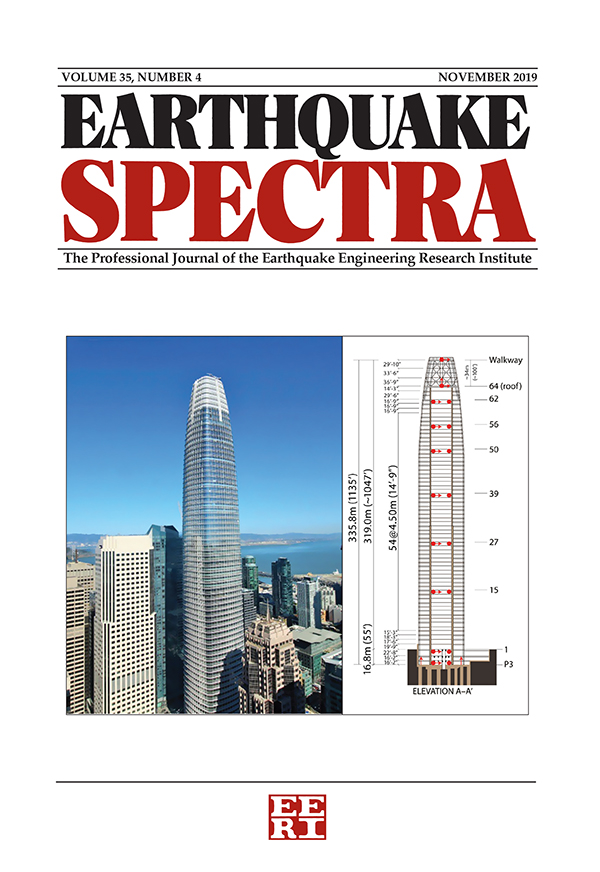Horizontal ground-motion model for subduction slab earthquakes using offshore ground motions in the Japan Trench area
IF 3.7
2区 工程技术
Q2 ENGINEERING, CIVIL
引用次数: 0
Abstract
The S-net, a large-scale network of permanent ocean-bottom seismographs in the Japan Trench, consisting of 150 stations, has recorded a large number of offshore ground motions that can be used to establish the empirical attenuation relationship of offshore ground motions in the subduction zone. Due to the different attenuation characteristics among different earthquake types in subduction zones, the earthquakes are classified into four tectonic types of subduction slab, interface, shallow crustal, and upper-mantle earthquakes according to the classification scheme of Zhao et al. (2015). Predictive models and uncertainties in offshore ground motions were investigated for different earthquake types. This study establishes a horizontal offshore subduction slab earthquake ground-motion model (GMM) and compares the offshore and onshore slab earthquake GMMs. As the site conditions at ocean-bottom stations are different from those at land stations, the effects of water depth and sediment thickness are taken into account in the offshore slab earthquake GMM. Due to differences in the burial methods of ocean-bottom stations, stations were divided into buried and unburied to investigate the effects of the burial methods. Therefore, regression analysis was used to propose an offshore slab earthquake GMM considering the magnitude, focal depth, distance, water depth, sediment thickness, and burial method. By separating the within-event residuals, the single-station standard deviation is presented. Compared to the onshore GMM, the predicted spectra of the offshore GMM are significantly larger at long periods. For the attenuation rate, the offshore attenuation rate is lower than that of the onshore attenuation rate for short periods, but is basically consistent with the onshore attenuation rate for long periods. The proposed GMM can be used to predict the offshore ground motions for slab earthquakes with rupture distances less than 300 km, focal depths less than 110 km, and moment magnitude between 4 and 7.4.利用日本海沟地区离岸地面运动建立俯冲板块地震的水平地面运动模型
由 150 个台站组成的日本海沟大型永久海底地震仪网络 S 网记录了大量离岸地震动,可用于建立俯冲带离岸地震动的经验衰减关系。由于俯冲带内不同地震类型的衰减特征不同,根据 Zhao 等人(2015)的分类方案,将地震分为俯冲板块地震、界面地震、浅地壳地震和上地幔地震四种构造类型。研究了不同地震类型的离岸地动预测模型和不确定性。本研究建立了水平离岸俯冲板块地震地动模型(GMM),并对离岸和陆上板块地震地动模型进行了比较。由于海底台站的场地条件与陆地台站不同,离岸板块地震地动模型考虑了水深和沉积厚度的影响。由于海底台站的埋藏方式不同,为研究埋藏方式的影响,将台站分为埋藏台站和非埋藏台站。因此,利用回归分析提出了考虑震级、焦深、距离、水深、沉积厚度和埋藏方式的近海板状地震 GMM。通过分离事件内残差,提出了单站标准偏差。与陆上 GMM 相比,海上 GMM 的预测频谱在长周期时明显增大。在衰减率方面,短周期的离岸衰减率低于陆上衰减率,但长周期的离岸衰减率与陆上衰减率基本一致。所提出的 GMM 可用来预测破裂距离小于 300 千米、焦深小于 110 千米、矩震级介于 4 至 7.4 之间的板状地震的离岸地面运动。
本文章由计算机程序翻译,如有差异,请以英文原文为准。
求助全文
约1分钟内获得全文
求助全文
来源期刊

Earthquake Spectra
工程技术-工程:地质
CiteScore
8.40
自引率
12.00%
发文量
88
审稿时长
6-12 weeks
期刊介绍:
Earthquake Spectra, the professional peer-reviewed journal of the Earthquake Engineering Research Institute (EERI), serves as the publication of record for the development of earthquake engineering practice, earthquake codes and regulations, earthquake public policy, and earthquake investigation reports. The journal is published quarterly in both printed and online editions in February, May, August, and November, with additional special edition issues.
EERI established Earthquake Spectra with the purpose of improving the practice of earthquake hazards mitigation, preparedness, and recovery — serving the informational needs of the diverse professionals engaged in earthquake risk reduction: civil, geotechnical, mechanical, and structural engineers; geologists, seismologists, and other earth scientists; architects and city planners; public officials; social scientists; and researchers.
 求助内容:
求助内容: 应助结果提醒方式:
应助结果提醒方式:


